
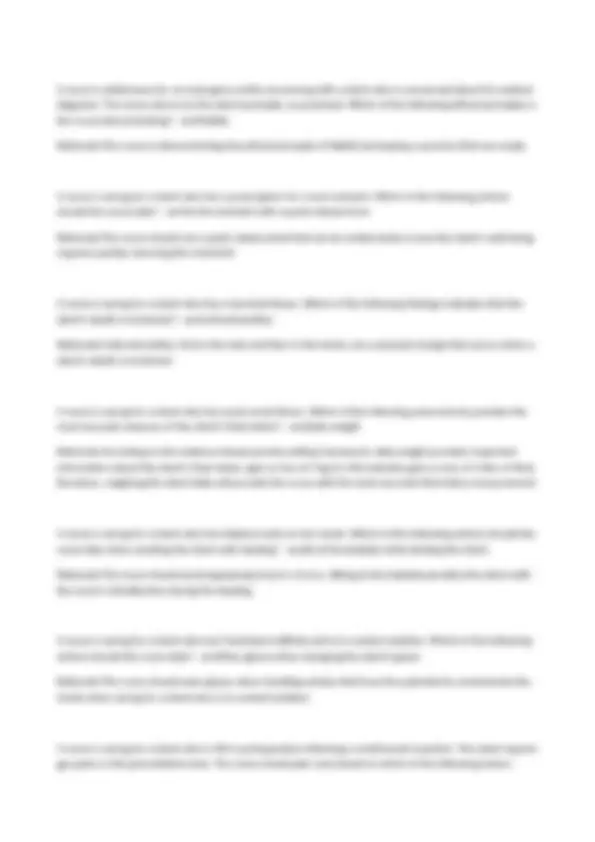
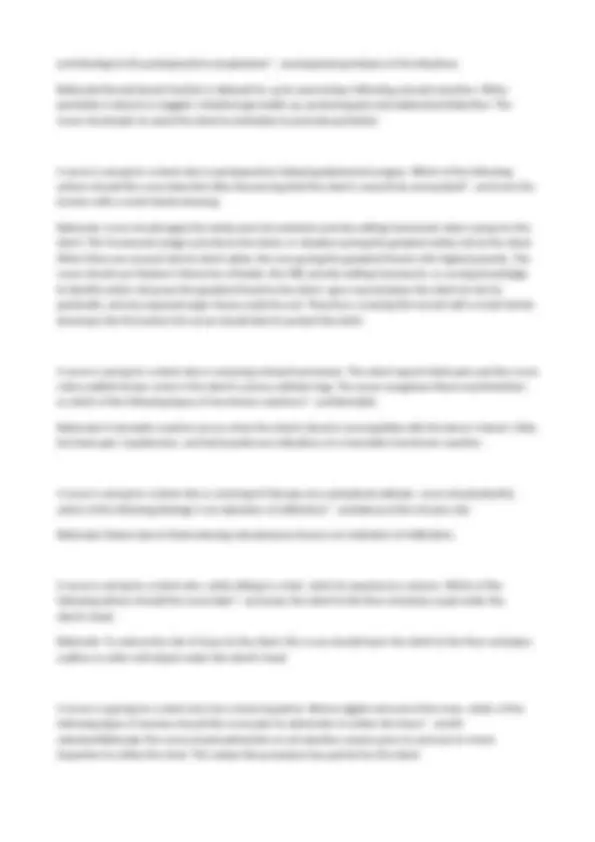
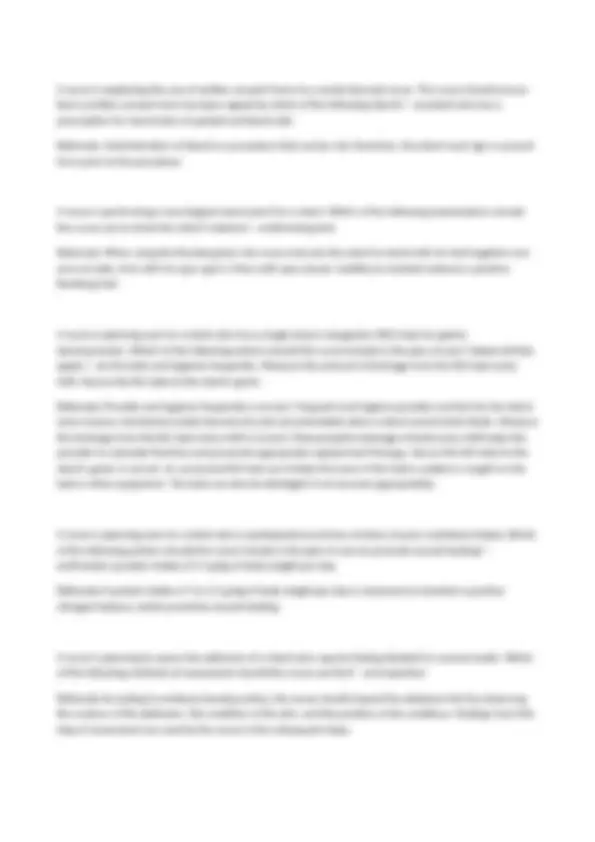
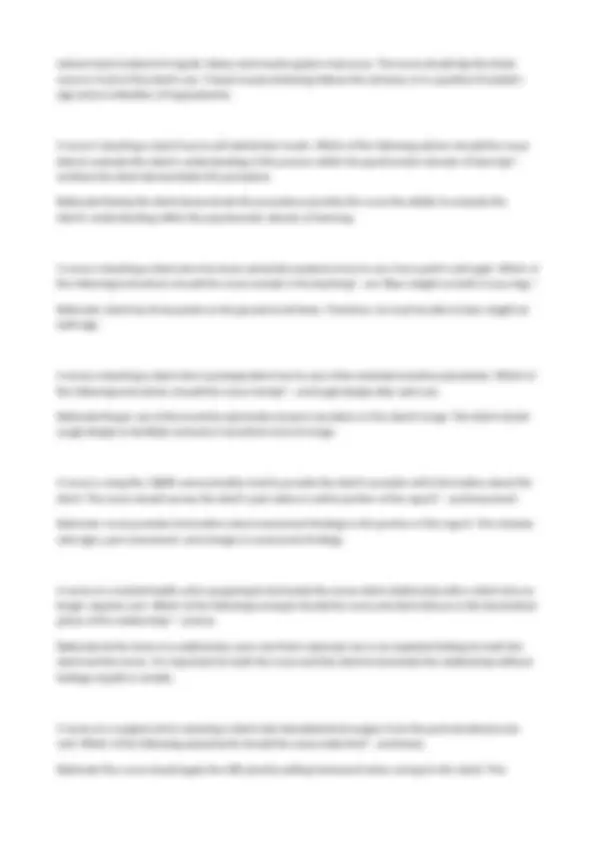
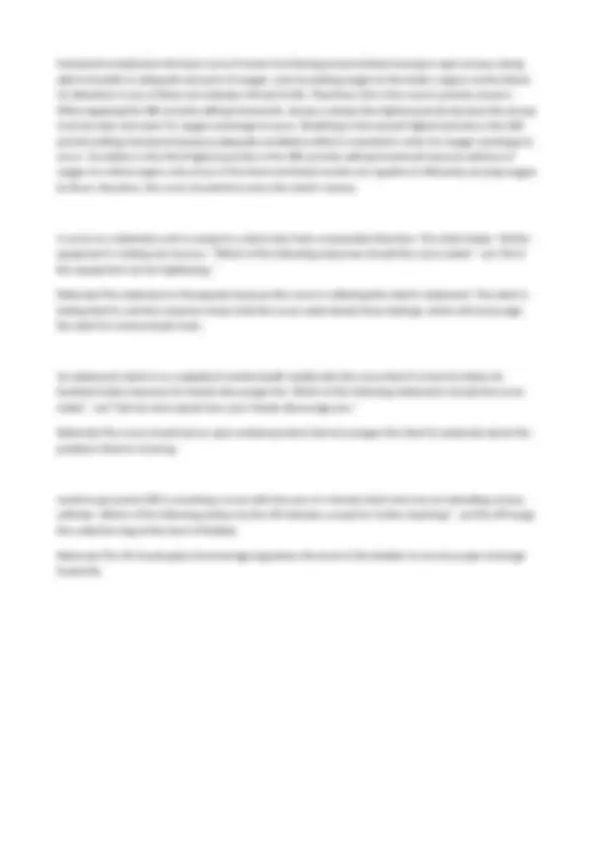


Study with the several resources on Docsity

Earn points by helping other students or get them with a premium plan


Prepare for your exams
Study with the several resources on Docsity

Earn points to download
Earn points by helping other students or get them with a premium plan
Community
Ask the community for help and clear up your study doubts
Discover the best universities in your country according to Docsity users
Free resources
Download our free guides on studying techniques, anxiety management strategies, and thesis advice from Docsity tutors
Learning system RN funds 3.0 Final Questions and Answers A client is being discharged home with oxygen therapy via a nasal cannula. Which of the following instructions should the nurse provide to the client and family? - ansWear cotton clothing to avoid static electricity. Rationale:The use of cotton clothing will limit the buildup of static electricity. Oxygen is a highly combustible gas. The use of oxygen in high concentrations has great combustion potential and readily fuels fire. Although it will not spontaneously burn or cause an explosion, it can easily cause a fire in a client's room if it contacts a spark.
Typology: Exercises
1 / 9

This page cannot be seen from the preview
Don't miss anything!






A client is being discharged home with oxygen therapy via a nasal cannula. Which of the following instructions should the nurse provide to the client and family? - ansWear cotton clothing to avoid static electricity. Rationale:The use of cotton clothing will limit the buildup of static electricity. Oxygen is a highly combustible gas. The use of oxygen in high concentrations has great combustion potential and readily fuels fire. Although it will not spontaneously burn or cause an explosion, it can easily cause a fire in a client's room if it contacts a spark. A client who reports shortness of breath requests her nurse's help in changing positions. After repositioning the client, which of the following actions should the nurse take next? Observe the rate, depth, and character of the client's respirations.Rationale:The nurse should apply the nursing process priority-setting framework when caring for this client. The nurse can use the nursing process to plan client care and prioritize nursing actions. Each step of the nursing process builds on the previous step, beginning with assessment or data collection. Before the nurse can formulate a plan of action, implement a nursing intervention, or notify a provider of a change in the client's status, the nurse must first collect adequate data from the client. Assessing or collecting additional data will provide the nurse with knowledge to make an appropriate decision; therefore, the first action the nurse should take is to assess - ansObserve the rate, depth, and character of the client's respirations. Rationale: nurse should apply the nursing process priority-setting framework when caring for this client. The nurse can use the nursing process to plan client care and prioritize nursing actions. Each step of the nursing process builds on the previous step, beginning with assessment or data collection. Before the nurse can formulate a plan of action, implement a nursing intervention, or notify a provider of a change in the client's status, the nurse must first collect adequate data from the client. Assessing or collecting additional data will provide the nurse with knowledge to make an appropriate decision; therefore, the first action the nurse should take is to assess the client's respiratory status. A home health nurse is planning to provide health promotion activities for a group of clients in the community. Which of the following activities is an example of the nurse promoting primary prevention? - ansEducating clients about the recommended immunization schedule for adults Rationale: Primary prevention includes health education about disease prevention. A newly licensed nurse is preparing to administer medications to a client. The nurse notes that the provider has prescribed a medication that is unfamiliar to her. Which of the following actions should the nurse take?
A nurse in a long-term care facility is admitting a client who is incontinent and smells strongly of urine. His partner, who has been caring for him at home, is embarrassed and apologizes for the smell. Which of the following responses should the nurse make? - ans"It must be difficult to care for someone who is confined to bed." Rationale:This response addresses the feelings of the partner by reflecting on her feelings. It facilitates therapeutic communication because it is nonjudgmental and encourages the partner to express her feelings. A nurse in a provider's office is assessing a client who has heart failure. The client has gained weight since her last visit and her ankles are edematous. Which of the following findings by the nurse is another clinical manifestation of fluid volume excess? - ansBounding pulse Rationale: Bounding pulse is an expected finding of fluid volume excess. A nurse in a provider's office is collecting information from an older adult client who reports that he has been taking acetaminophen 500 mg/day for severe joint pain. The nurse should instruct the client that large doses of acetaminophen could cause which of the following adverse effects? - ansLiver Damage Rationale: Acetaminophen in large doses can be toxic to liver. Daily intake should be limited to less than 3 to 4 grams per day for healthy individuals n 2.4 grams per day for older adults n those with history of liver impairment. A nurse in a provider's office is reviewing the laboratory findings of a client who reports chills and aching joints. The nurse should identify which of the following findings as an indication that the client has an infection? - ansWBC 15,000 mm Rationale: This finding is above the expected reference range and is an indication of infection. A nurse in the emergency department is caring for a client who has abdominal trauma. Which of the following assessment findings should the nurse identify as an indication of hypovolemic shock? - ansTachycardia Rationale:Due to the decrease in circulating blood volume that occurs with internal bleeding, the oxygen- carrying capacity of the blood is reduced. The body attempts to relieve the hypoxia by increasing the heart rate and cardiac output, along with increasing the respiratory rate. A nurse is applying an ice bag to the ankle of a client following a sports injury. Which of the following actions should the nurse take? - ansFill the bag two-thirds full with ice. Rationale:The nurse should fill the bag two-thirds full with ice, which makes it possible to mold the bag around the client's ankle.
contributing to this postoperative complication? - ansImpaired peristalsis of the intestines Rationale:Normal bowel function is delayed for up to several days following a bowel resection. When peristalsis is absent or sluggish, intestinal gas builds up, producing pain and abdominal distention. The nurse should plan to assist the client to ambulate to promote peristalsis. A nurse is caring for a client who is postoperative following abdominal surgery. Which of the following actions should the nurse take first after discovering that the client's wound has eviscerated? - ansCover the incision with a moist sterile dressing. Rationale: nurse should apply the safety and risk reduction priority-setting framework when caring for this client. This framework assigns priority to the factor or situation posing the greatest safety risk to the client. When there are several risks to client safety, the one posing the greatest threat is the highest priority. The nurse should use Maslow's Hierarchy of Needs, the ABC priority-setting framework, or nursing knowledge to identify which risk poses the greatest threat to the client. open wound places the client at risk for peritonitis, and any exposed organ tissue could dry out. Therefore, covering the wound with a moist sterile dressing is the first action the nurse should take to protect the client. A nurse is caring for a client who is receiving a blood transfusion. The client reports flank pain and the nurse notes reddish-brown urine in the client's urinary catheter bag. The nurse recognizes these manifestations as which of the following types of transfusion reactions? - ansHemolytic Rationale:A hemolytic reaction occurs when the client's blood is incompatible with the donor's blood. Chills, low back pain, hypotension, and tachycardia are indications of a hemolytic transfusion reaction. A nurse is caring for a client who is receiving IV therapy via a peripheral catheter. nurse should identify which of the following findings is an indication of infiltration? - ansEdema at the infusion site Rationale: Edema due to fluid entering subcutaneous tissue is an indication of infiltration. A nurse is caring for a client who, while sitting in a chair, starts to experience a seizure. Which of the following actions should the nurse take? - ansLower the client to the floor and place a pad under the client's head. Rationale: To reduce the risk of injury to the client, the nurse should lower the client to the floor and place a pillow or other soft object under the client's head. A nurse is cqaring for a client who has a fecal impaction. Before digital removal of the mass, which of the following types of enemas should the nurse plan to administer to soften the feces? - ansOil retentionRationale:The nurse should administer an oil retention enema prior to removal of a fecal impaction to soften the stool. This makes the procedure less painful for the client.
A nurse is explaining the use of written consent forms to a newly-licensed nurse. The nurse should ensure that a written consent form has been signed by which of the following clients? - ansclient who has a prescription for transfusion of packed red blood cells Rationale: Administration of blood is a procedure that carries risk; therefore, the client must sign a consent form prior to the procedure. A nurse is performing a neurological assessment for a client. Which of the following examinations should the nurse use to check the client's balance? - ansRomberg test Rationale: When using the Romberg test, the nurse instructs the client to stand with his feet together and arms at sides, first with his eyes open n then with eyes closed. inability to maintain balance is positive Romberg test. A nurse is planning care for a client who has a single-lumen nasogastric (NG) tube for gastric decompression. Which of the following actions should the nurse include in the plan of care? (Select all that apply.) - ans-Provide oral hygiene frequently.-Measure the amount of drainage from the NG tube every shift.-Secure the NG tube to the client's gown. Rationale:-Provide oral hygiene frequently is correct. Frequent oral hygiene provides comfort for the client since mucous membranes easily become dry and uncomfortable when a client cannot drink fluids.-Measure the drainage from the NG tube every shift is correct. Measuring the drainage at least every shift helps the provider to calculate fluid loss and prescribe appropriate replacement therapy.-Secure the NG tube to the client's gown is correct. An unsecured NG tube can irritate the nares if the tube is pulled or caught on the bed or other equipment. The tube can also be dislodged if not secured appropriately. A nurse is planning care for a client who is postoperative and has a history of poor nutritional intake. Which of the following actions should the nurse include in the plan of care to promote wound healing? - ansProvide a protein intake of 1.5 g/kg of body weight per day. Rationale:A protein intake of 1 to 1.5 g/kg of body weight per day is necessary to maintain a positive nitrogen balance, which promotes wound healing. A nurse is planning to assess the abdomen of a client who reports feeling bloated for several weeks. Which of the following methods of assessment should the nurse use first? - ansInspection Rationale:According to evidence-based practice, the nurse should inspect the abdomen first by observing the contour of the abdomen, the condition of the skin, and the position of the umbilicus. Findings from this step of assessment are used by the nurse in the subsequent steps.
A nurse is providing education about cultural and religious traditions and rituals related to death for the assistive personnel on the unit. Which of the following information should the nurse include? - ansPeople who practice Judaism stay with the body of the deceased until burial. Rationale:In the Jewish faith, a family member often stays with the body until burial occurs. A nurse is providing oral care for a client who is unconscious. Which of the following actions should the nurse take? - ansPlace the client in a lateral position with the head turned to the side before beginning the procedure. Rationale:The nurse should place the client in a lateral position with the head turned to the side to reduce the risk of aspiration of fluids and secretions. A nurse is providing teaching about food choices to a client who has a prescription for a clear liquid diet. Which of the following selections by the client indicates an understanding of the teaching? - ansGelatin Rationale:Foods allowed on a clear liquid diet are those that are clear and liquid at room temperature. A nurse is responding to a parent's question about his infant's expected physical development during the first year of life. Which of the following information should the nurse include? - ans10-month-old infant can pull up to a standing position. Rationale: 8 to 10-month-old infant can pull himself to a standing position. A nurse is reviewing measures to prevent back injuries with assistive personnel (AP). Which of the following instructions should the nurse include? - ansWhen lifting an object, spread your feet apart to provide a wide base of support. Rationale:The AP should spread his feet apart because a wide base of support increases stability. A nurse is reviewing the correct use of a fire extinguisher with a client. Which of the following actions should the nurse direct the client to take first? - ansRemove the safety pin from the extinguisher. Rationale:Evidenced-based practice indicates removing the safety pin from the extinguisher is the first action to take when using a fire extinguisher; therefore, this is the action the nurse should instruct the client to take first. A nurse is reviewing the laboratory values for a client who has a positive Chvostek's sign. Which of the following laboratory findings should the nurse expect? - ansDecreased calcium Rationale:Calcium is necessary for nerve conduction and muscle contractions. When the client's total
calcium level is below 8.4 mg/dL, tetany and muscle spasms may occur. The nurse should tap the facial nerve in front of the client's ear. If facial muscle twitching follows this stimulus, it is a positive Chvostek's sign and an indication of hypocalcemia. A nurse is teaching a client how to self-administer insulin. Which of the following actions should the nurse take to evaluate the client's understanding of the process within the pyschomotor domain of learning? - ansHave the client demonstrates the procedure. Rationale:Having the client demonstrate the procedure provides the nurse the ability to evaluate the client's understanding within the psychomotor domain of learning. A nurse is teaching a client who has lower extremity weakness how to use a four-point crutch gait. Which of the following instructions should the nurse include in the teaching? - ans"Bear weight on both of your legs." Rationale: client has three points on the ground at all times. Therefore, he must be able to bear weight on both legs. A nurse is teaching a client who is postoperative how to use a flow-oriented incentive spirometer. Which of the following instructions should the nurse include? - ansCough deeply after each use. Rationale:Proper use of the incentive spirometer loosens secretions in the client's lungs. The client should cough deeply to facilitate removal of secretions from his lungs. A nurse is using the I-SBAR communication tool to provide the client's provider with information about the client. The nurse should convey the client's pain status in which portion of the report? - ansAssessment Rationale: nurse provides information about assessment findings in this portion of the report. This includes vital signs, pain assessment, and changes in assessment findings. A nurse on a mental health unit is preparing to terminate the nurse-client relationship with a client who no longer requires care. Which of the following concepts should the nurse and client discuss in the termination phase of the relationship? - ansLoss Rationale:At the close of a relationship, even one that is planned, loss is an expected feeling for both the client and the nurse. It is important for both the nurse and the client to terminate the relationship without feelings of guilt or anxiety. A nurse on a surgical unit is receiving a client who had abdominal surgery from the post-anesthesia care unit. Which of the following assessments should the nurse make first? - ansAirway Rationale:The nurse should apply the ABC priority-setting framework when caring for this client. This